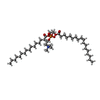+Search query
-Structure paper
| Title | Structure-guided unlocking of Na reveals a non-selective tetrodotoxin-sensitive cation channel. |
|---|---|
| Journal, issue, pages | Nat Commun, Vol. 13, Issue 1, Page 1416, Year 2022 |
| Publish date | Mar 17, 2022 |
 Authors Authors | Cameron L Noland / Han Chow Chua / Marc Kschonsak / Stephanie Andrea Heusser / Nina Braun / Timothy Chang / Christine Tam / Jia Tang / Christopher P Arthur / Claudio Ciferri / Stephan Alexander Pless / Jian Payandeh /    |
| PubMed Abstract | Unlike classical voltage-gated sodium (Na) channels, Na has been characterized as a voltage-insensitive, tetrodotoxin-resistant, sodium (Na)-activated channel involved in regulating Na homeostasis. ...Unlike classical voltage-gated sodium (Na) channels, Na has been characterized as a voltage-insensitive, tetrodotoxin-resistant, sodium (Na)-activated channel involved in regulating Na homeostasis. However, Na remains refractory to functional characterization in traditional heterologous systems. Here, to gain insight into its atypical physiology, we determine structures of the human Na channel in complex with the auxiliary β3-subunit. Na reveals structural alterations within the selectivity filter, voltage sensor-like domains, and pore module. We do not identify an extracellular Na-sensor or any evidence for a Na-based activation mechanism in Na. Instead, the S6-gate remains closed, membrane lipids fill the central cavity, and the domain III-IV linker restricts S6-dilation. We use protein engineering to identify three pore-wetting mutations targeting the hydrophobic S6-gate that unlock a robust voltage-insensitive leak conductance. This constitutively active Na-QTT channel construct is non-selective among monovalent cations, inhibited by extracellular calcium, and sensitive to classical Na channel blockers, including tetrodotoxin. Our findings highlight a functional diversity across the Na channel scaffold, reshape our understanding of Na physiology, and provide a template to demystify recalcitrant ion channels. |
 External links External links |  Nat Commun / Nat Commun /  PubMed:35301303 / PubMed:35301303 /  PubMed Central PubMed Central |
| Methods | EM (single particle) |
| Resolution | 2.9 - 3.2 Å |
| Structure data | EMDB-25919, PDB-7tj8: EMDB-25920, PDB-7tj9: |
| Chemicals |  ChemComp-PEV:  ChemComp-POV:  ChemComp-PLM:  ChemComp-NAG:  ChemComp-CLR:  ChemComp-Q7G: |
| Source |
|
 Keywords Keywords | METAL TRANSPORT / Sodium Channel / NaV / Ion Channel / TRANSPORT PROTEIN |
 Movie
Movie Controller
Controller Structure viewers
Structure viewers About Yorodumi Papers
About Yorodumi Papers







 homo sapiens (human)
homo sapiens (human)